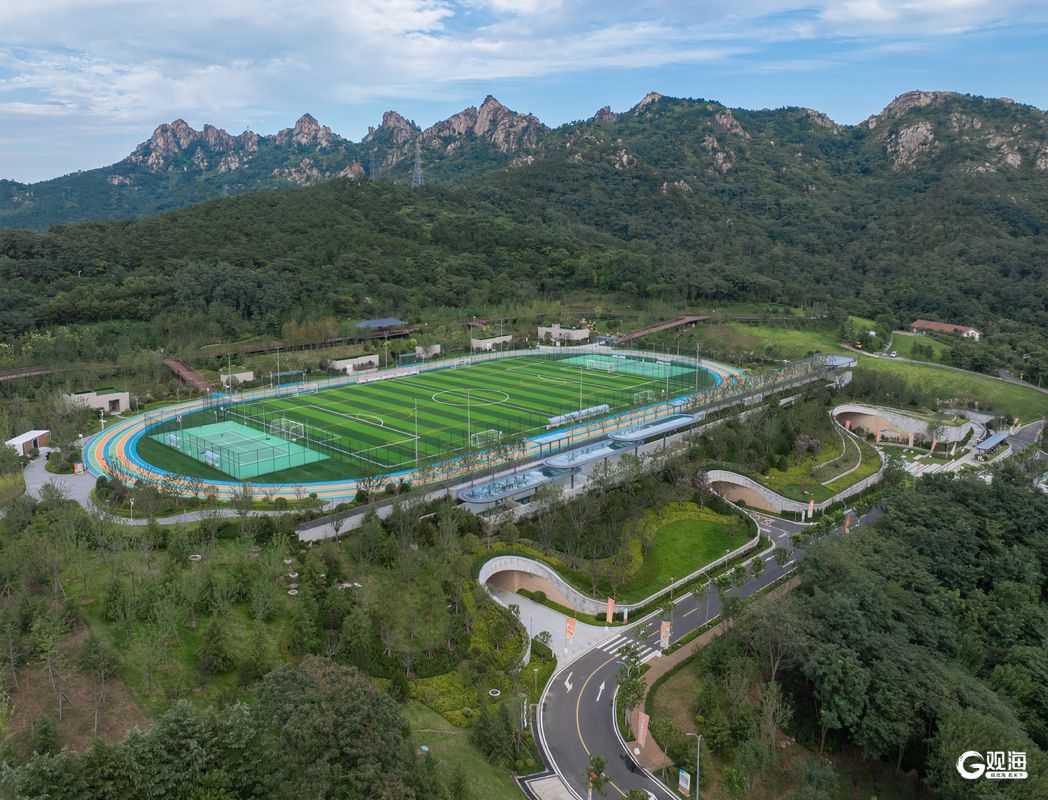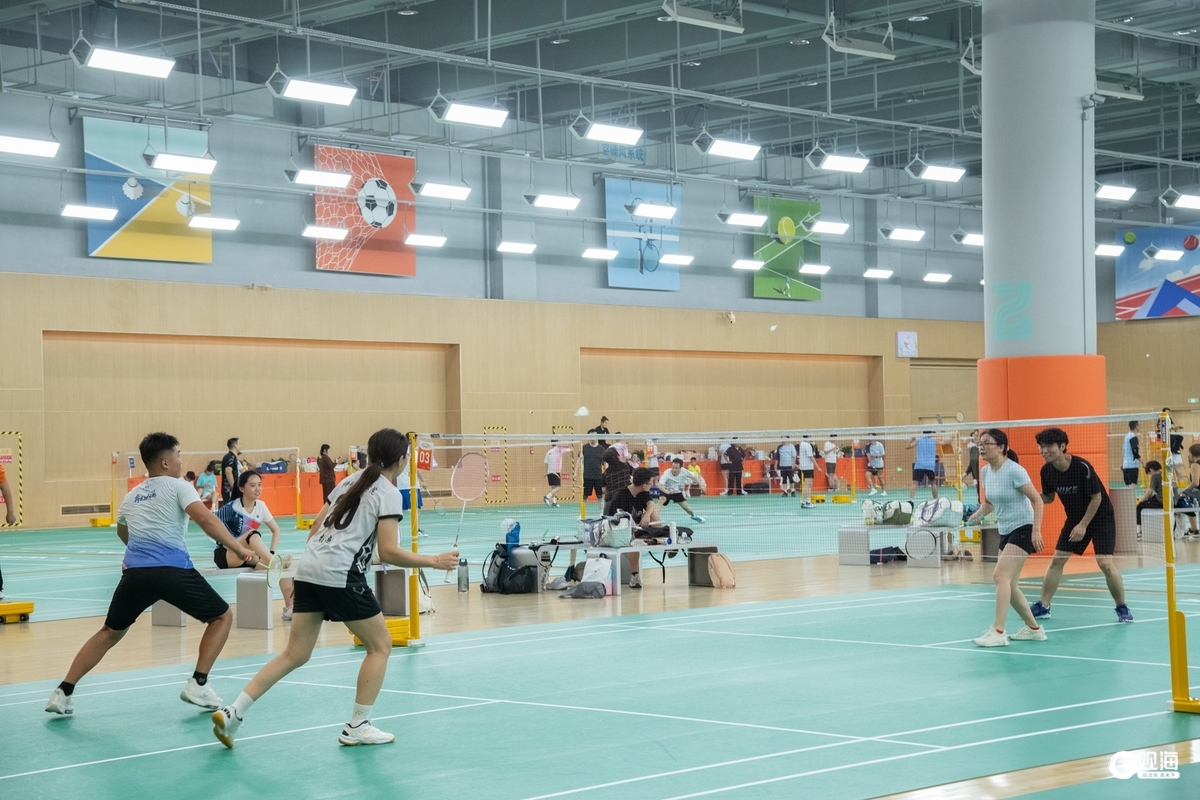With over 1,000 green spaces, the coastal metropolis is redefining urban living by weaving nature into the fabric of daily life.
The city now boasts 1,031 parks of various types, which deliver lasting ecological, aesthetic, and cultural value while paving the way for more people-centric green initiatives.
During the recent holiday, parks were the undisputed top choice for leisure. At Fushan Forest Park, vibrant tents speckled the lawns where families and friends gathered in laughter-filled conversations. Maidao Park exuded romance, becoming a favorite backdrop for couples and aspiring photographers, each snapshot capturing a moment of idyllic charm. Meanwhile, a different perspective awaited at Xiaoyu Hill Park, where visitors leaned against railings to soak in Qingdao's signature vista of red roofs, green trees, blue seas, and azure skies.
 An aerial view of the Fushan Forest Park. Photo by Liu Dong.
An aerial view of the Fushan Forest Park. Photo by Liu Dong.
According to official data, Qingdao is now home to 1,031 parks, including 330 urban parks, 687 pocket parks, and 14 forest parks, officially earning its "City of a Thousand Parks" status. This milestone reflects a profound shift in urban development philosophy and stands as a testament to its commitment to enhancing public well-being through shared green spaces.
As a vital part of the urban ecosystem, parks not only drive the city's green transformation but also serve as essential venues for recreation and connecting with nature, significantly boosting the city's quality of life.
From historic old-town corners to the wide avenues of new districts, and from the coastline to the forested hills, these parks are like pearls woven into the city’s fabric. Together, they form a comprehensive green network for all residents, serving as the city's "green lungs," cultural anchors, and vibrant stages for community life.
A New Green Blueprint for the City
Qingdao's "thousand parks" encompass a diverse range, including urban, pocket, and forest parks. Each is designed in harmony with its local environment, culture, and ecology, effectively redrawing the city's green map and delivering tangible benefits to its citizens.
Urban parks are public green spaces designed primarily for recreation, while smaller, accessible pocket parks are nestled within communities. Forest parks, centered on ecological preservation, are built around extensive woodlands and wildlife habitats.
 Taipingshan Central Park, seen from above. Photo by Liang Chao.
Taipingshan Central Park, seen from above. Photo by Liang Chao.
Where Every Park Has a Story to Tell
While Qingdao's parks share a common beauty, each one has its unique "memory point."
In recent years, Maidao Park has become a social media sensation, drawing huge crowds during holidays. This 0.157-square-kilometer island, once neglected due to ecological decline, has been transformed through restoration and landscape upgrades into a coveted escape. As one netizen commented: "Lush lawns meeting the vast sea—this is romance brought to life in Qingdao."
 Maidao Park, now a top destination for visitors and influencers. Photo by Liu Dong.
Maidao Park, now a top destination for visitors and influencers. Photo by Liu Dong.
This year, the Maidao Road West Parking Lot Park opened nearby. As Qingdao’s first three-dimensional "underground-ground-aerial" complex, it not only eases parking congestion but also boasts a stunning 20,000-square-meter coastal park on its ground level. It artfully integrates art installations, rest areas, sports zones, and a cloud-like viewing bridge, completely reimagining the coastal experience.
 The "parking + park + cloud bridge" concept redefines the coastal experience at the new park. Photo by Liu Dong.
The "parking + park + cloud bridge" concept redefines the coastal experience at the new park. Photo by Liu Dong.
Such innovative designs are a hallmark of Qingdao's park development. Fudao Park, an award-winning "hanging garden" at the intersection of two major roads, is a prime example of urban renewal that blends transport, scenery, and cultural heritage.
Beyond aesthetics, these parks serve critical ecological roles. "Generally, the more complex a plant community is in an urban setting, the more stable its ecosystem," noted a landscape expert. "Diverse vegetation enhances biodiversity, regulates the microclimate, and mitigates the urban heat island effect."
Many parks are now also embracing distinct themes. Sifang Locomotive Park, the sole preserved section of an old factory, is filled with nostalgic charm, where old equipment has been repurposed into art, breathing new life into industrial heritage. Others, like Lao She Park, honor historical figures connected to the city, enriching Qingdao’s cultural character.
Through urban micro-renewal projects, the city is also unlocking the green potential of forgotten scraps of land. By redesigning traffic flows and incorporating age- and child-friendly features, these spaces now cater to all generations, making green living truly accessible.
Small is Beautiful: Low-Carbon, Community-Driven Green Projects
With the expansion of green coverage, the focus has shifted to integrating nature into the city's multi-dimensional spaces. This year, Qingdao has committed to making park city development a sustained effort, prioritizing facilities that are "low-cost, low-maintenance, and low-carbon."
In Laoshan District, for example, landscapers have moved away from replacing seasonal flowers every few months. Instead, they use over 70 species of locally adapted perennials and ornamental grasses to create lasting, beautiful flower borders and micro-landscapes. "These mixed-plant flowerbeds have a longer blooming season, offer dynamic seasonal views, and require less maintenance," explained a professional. "It's a proactive step towards a more sustainable approach to landscaping."
Even more profound changes are taking root at the community level. In May, a "micro-garden" initiative captured public interest. Unlike traditional projects, residents were deeply involved in every stage, from site selection to planting and upkeep. Officials stated that these gardens follow a "small investment, micro-impact" principle, revitalizing overlooked "leftover spaces." Through surveys and community outreach, public opinion was central, empowering residents as true partners and beneficiaries of urban greening.
Today, a hundred of these micro-gardens have bloomed across the city. Each reflects its local ecology, providing not only a home for plants but also a "green living room" for neighbors, a natural classroom for children, and a welcoming corner for seniors.
Looking ahead, the city will continue to a focus from sheer scale to quality, championing the "Park City" ideal and building more people-centric green spaces guided by public needs.
More Than Greenery: The "Park+" Strategy Energizes Urban Life
As the number of parks grows, the challenge becomes maximizing their overall impact. Qingdao is now fostering a deep integration of park resources into daily life, using them as core green infrastructure. Through the "Park+" model—which blends parks with services, experiences, culture, tourism, and sports—the city is achieving a holistic upgrade of its urban space, function, and culture.
Reflecting the national fitness boom, the Fushan National Fitness Center recently opened, cleverly nestled in the mountain forest. It houses professional venues for badminton, tennis, basketball, and fencing. Its badminton hall boasts a 12-meter-high ceiling and 40 courts meeting international standards. A greenway now connects directly to the center's rooftop rainbow running track, creating a seamless circuit for both exercise and scenic views.
 Residents enjoying the new facilities at the Fushan National Fitness Center. Photo by Liu Dong.
Residents enjoying the new facilities at the Fushan National Fitness Center. Photo by Liu Dong.
Similarly, parks like Shenzhen Road Sports Park are becoming vibrant hubs for all ages through creative design, technology, and new business models. They offer far more than just fitness areas; they are evolving into multi-functional venues for events, social gatherings, and leisure consumption, unlocking the vast economic potential of the "Park+" concept.
Nighttime in the parks is just as exciting. A recent grand lantern festival at Taipingshan Central Park drew massive crowds. Themed "A Dream Woven of Mountains and Seas, A Thousand Lanterns Mirrored in the Starry Bay," the 83-day event was both a visual spectacle and a masterclass in urban marketing, attracting 300,000 visitors and driving significant consumer spending.
What do parks truly mean to a city? Globally, from New York's Central Park to London's Hyde Park, parks are more than just green ornaments; they are definitive indicators of a city's competitiveness, livability, and governance.
For Qingdao, its parks serve as gyms for seniors, a favorite for family outings, and a "recharging station" for the younger generation—an inviting urban living room for all. As one expert concludes, through spatial redesign, functional integration, and extended hours, parks are meeting a wide array of needs for leisure, sports, culture, and consumption, becoming an inseparable part of life in the city.
Becoming a "City of a Thousand Parks" is not the final destination for Qingdao but a new starting point. It signals a greener environment, healthier lifestyles, more inclusive communities, and a sustainable future. On this path toward harmony between humanity and nature, Qingdao is using its parks as the brush and the city as the scroll to paint a living, breathing ecological masterpiece.
(By Liu Dong, Qingdao Daily/Guanhai News)
Editor: Yuan Ruichen




